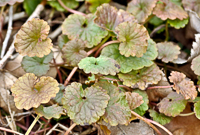 Creeping Charlie
(Glechoma
hederacea) also known as ground ivy,
creeping jenny and gill-over-the-ground is a very aggressive plant especially in shady
areas or on soils that have become compacted. It
is very difficult to control because of its
growth habit. Long above ground stems (stolons) spread out
and where they touch the ground, new roots and a
new plant
develops.
Creeping Charlie
(Glechoma
hederacea) also known as ground ivy,
creeping jenny and gill-over-the-ground is a very aggressive plant especially in shady
areas or on soils that have become compacted. It
is very difficult to control because of its
growth habit. Long above ground stems (stolons) spread out
and where they touch the ground, new roots and a
new plant
develops.
As always, keeping the desired turfgrass healthy
and vigorous is the number one approach to
controlling this weed. This
means mowing tall (2.5 inches or more),
fertilizing properly and watering during periods
of hot, dry weather. Since Creeping Charlie can
thrive in hard soils, periodic core aeration may
be key to keeping it under control.
Hand removal is a short term control since it
leaves a small part of the plant in the ground
and a new plant will develop from that piece.
In some university research,
borax (sodium tetraborate, a white, crystalline
mineral salt) has been found to be effective
herbicide against Creeping Charlie. However,
this does not always work depending on your soil
type and, if not done properly, may lead to a
toxic level of
boron that will affect other
plants too. Here's some info from the
University of Minnesota.
You can use chemical herbicides but, unless you
change the conditions so that the grass will
thrive, the Creeping Charlie will be back.
Herbicides labeled for "difficult to control"
lawn weeds may be effective, however, those that
rely solely on
2,4-D will not.
Timing of applications is also very important.
The first or second week of October is the best
time since that is when this perennial plant is
sending carbohydrates down to the root system in
preparation for winter. If the chemical is on
the leaf, it too goes down and kills the root
system. Spring when the plant is in bloom is the
second best time since the translocation is also
happening at that time. The heat of summer is a
poor time to try chemical control.
Also, try to picture what the turf would look
like if the Creeping Charlie were gone. If the
area is primarily Creeping Charlie and there
would only be a few blades of grass left, you
may need to kill the infested area with a
non-selective, post emergent herbicide and
reseed. In this case, if you just kill the weed,
the sparse grass will not fill in before the
weeds return.



